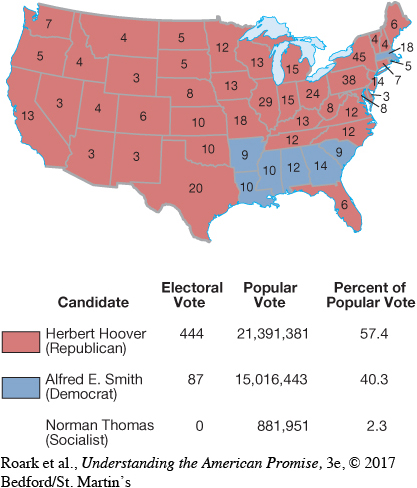Al Smith and the Election of 1928
The presidential election of 1928 brought many of the developments of the 1920s—prohibition, immigration, religion, and the clash of rural and urban values—into sharp focus. Republicans emphasized the economic success of their party’s pro-business government and turned to Herbert Hoover, the energetic secretary of commerce and leading public symbol of 1920s prosperity. But because both parties generally agreed that the American economy was basically sound, the campaign turned on social issues that divided Americans.
The Democrats nominated four-time governor of New York Alfred E. Smith. Smith adopted “The Sidewalk of New York” as a campaign theme song and seemed to represent all that rural Americans feared and resented. A child of immigrants, Smith got his start in politics with the help of New York City’s Irish-dominated Tammany Hall political machine, to many the epitome of big-city corruption. He denounced immigration quotas, signed New York State’s anti-Klan bill, and opposed prohibition, believing that it was a nativist attack on immigrant customs. When Smith supposedly asked reporters, “Wouldn’t you like to have your foot on the rail and blow the foam off some suds?” prohibition forces dubbed him “Alcohol Al.” But Smith’s greatest vulnerability in the heartland was his religion. He was the first Catholic to run for president. A Methodist bishop in Virginia denounced Roman Catholicism as “the Mother of ignorance, superstition, intolerance and sin” and begged Protestants not to vote for a candidate who represented “the kind of dirty people that you find today on the sidewalks of New York.”
> ANALYZE EVIDENCE
What do the results of the 1928 presidential election suggest about which social and cultural issues were most divisive in the United States at that time?
Hoover, who neatly combined the images of morality, efficiency, service, and prosperity, won the election by a landslide (Map 23.3). He received nearly 58 percent of the vote and gained 444 electoral votes to Smith’s 87. The only bright spot for Democrats was the nation’s cities, which voted Democratic, indicating the rising strength of ethnic minorities, including Smith’s fellow Catholics. [[LP Map: M23.03 The Election of 1928/

> QUICK REVIEW
How did some Americans resist cultural change?
Understanding the American Promise 3ePrinted Page 665
Section Chronology